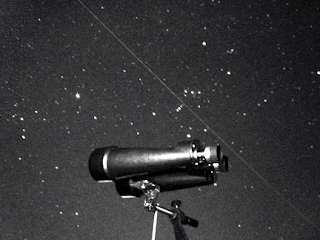









March 3: A Waning Gibbous Moon (18.23 days old) is just 4 degrees SE of Spica at 11:30pm in east.
March 7: The Moon will be just 1 degree from Antares at 6:00am.
March 7: Last Quarter Moon.
March 13-14: Messier Marathon. Locating all the 110 Messier objects from the evening of 14th to the morning of 14th March 2010.
March 14: Mercury Superior Conjunction.
March 16: New Moon.
March 17: A very thin Crescent Moon stands about 6.3 degrees N-NW from bright Venus. The pair will be very low in west just after sunset.
March 20: Equinox.
March 20: A Waxing Crescent moon stands 5 degrees West of The Pleiades Cluster (M45) just after evening.
March 22: Saturn opposition. (Dist. 8.5 A.U., Angular Size 20 Arc Sec., Mag. 0.53). On the night of 22nd an observer according to the Indian Standard time will see Titan very close to the Saturn’s North Pole at 9:20pm.
March 23: First Quarter Moon.
March 25: Moon and Mars are 5 degrees apart at 9:00pm.
March 26: Pluto Western Quadrature.
March 27: Moon and Regulus are 5 degrees apart.
PLANETS IN MARCH 2010
VENUS: Very low in west after sunset. Shining at magnitude -3.9, the planet will be just 4’09” from the star 20 Piscium (mag. 5.46) on March 4th. Venus will be paired with the moon on the evening of 17th. On 31st March, Venus will be paired with Mercury.
URANUS: Uranus will remain very low in west. The planet will be unable to observe during the month.
MARS: Mars now shines at magnitude -0.6 at the month’s beginning will remain in Cancer. Mars is well placed in the sky after sunset during March. The magnitude will drop down to 0.15 by month’s end.
SATURN: Saturn will rise around 8:20pm during month’s beginning. The ringed world will reach near opposition on March 22nd. The event of Moon Titan’s close passing to the planet’s North and South poles can be observed during this month. Here are the dates of Titan’s close passing according to Indian Standard Time.
· March 7 at 2:41am. North Pole
· March 14 at 10:35pm. South Pole
· March 22 at 11:31pm. North Pole
· March 30 at 8:25pm. South Pole
NEPTUNE: Neptune is very low in the eastern sky in the constellation Capricornus just before sunrise. It will move to Aquarius on March 24th.
MERCURY: Mercury is on Superior Conjunction on March 14th. Mercury will be paired with Venus on March 31st.
JUPITER: Jupiter will reappear in the morning sky on March 18th. Jupiter will be only 16’ from the Phi Aquarii star (mag. 4.21) on March 31st.